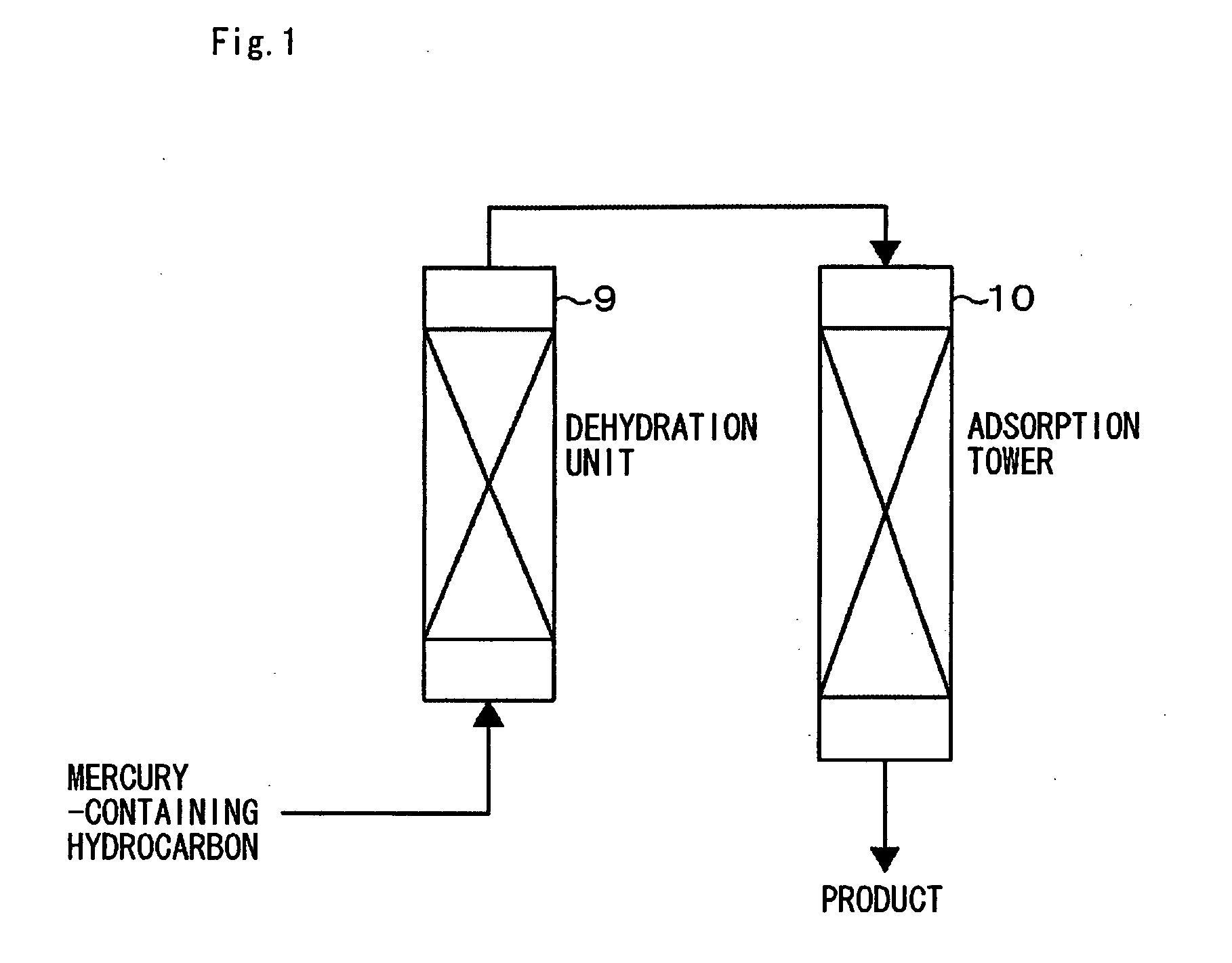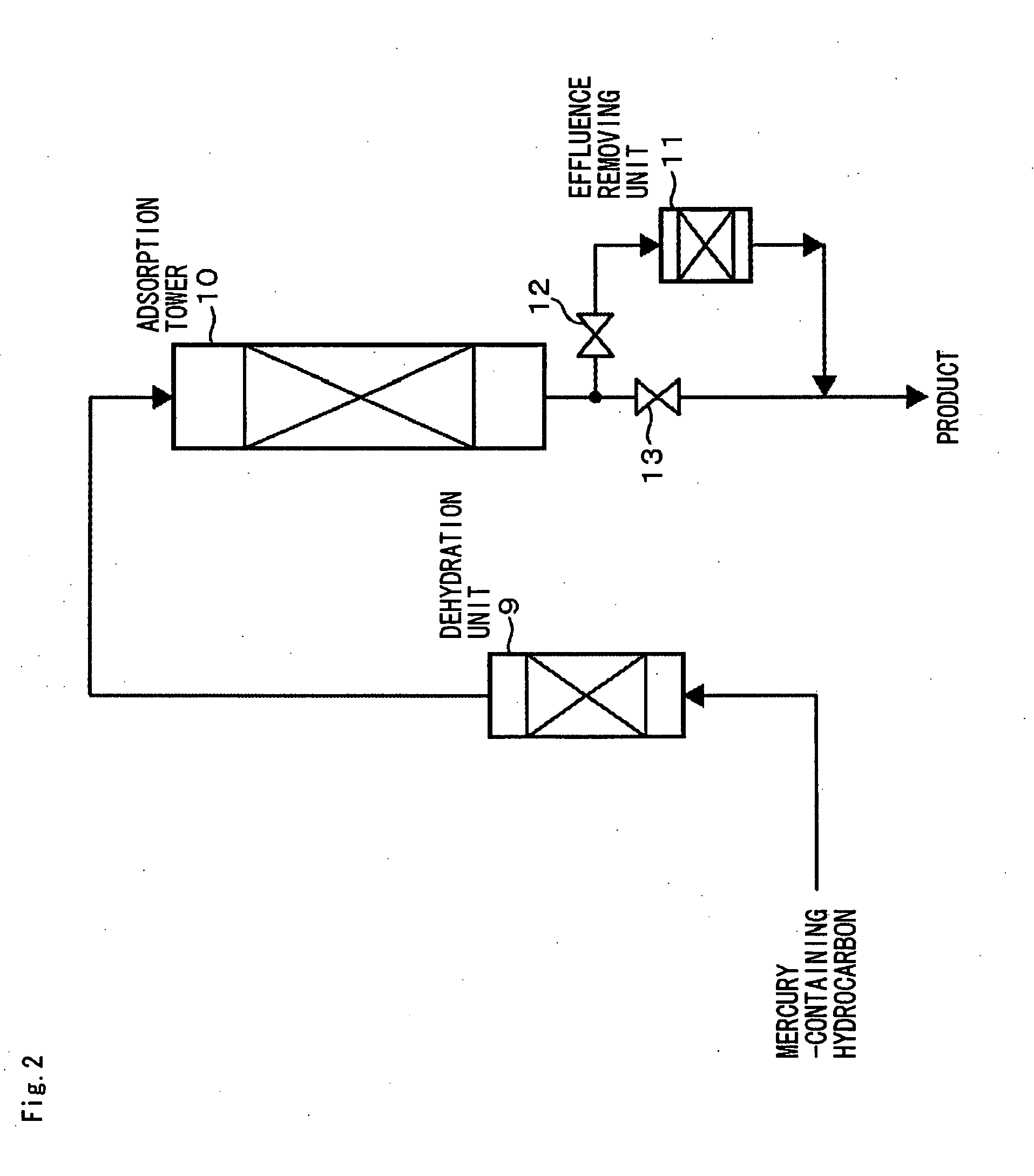Mercury-removal adsorbent ,method of producing mercury-removal adsorbent, and method of removing mercury by adsorption
a technology of adsorbent and mercury, which is applied in the field of mercury removal adsorbent, can solve the problems of preventing the activated carbon support from exhibiting sufficient mercury removal performance, difficult to adsorptively remove ionic or organic mercury using ordinary mercury adsorbent, and reducing the concentration of mercury adsorptively removable per unit weight of the adsorbent, so as to achieve the effect of reducing the concentration of mercury and greatly increasing the amount of mercury
- Summary
- Abstract
- Description
- Claims
- Application Information
AI Technical Summary
Benefits of technology
Problems solved by technology
Method used
Image
Examples
examples
Tests of Adsorptively Removing Mercury Contained in Liquid Hydrocarbon
A. Preconditions of the Tests
[0033]n-hexane was used as liquid hydrocarbon. Tests of adsorptively removing mercuries in various forms were conducted by dissolving organic mercury (diethyl mercury), ionic mercury (mercapto mercury), and elemental mercury in the liquid hydrocarbons.
[0034]Batch adsorption tests were conducted in which mercury-containing liquid hydrocarbons were brought into contact with various kinds of mercury-removal adsorbents in a reactor. Table 1 shows test conditions.
TABLE 1Test Conditionstest methodbatch testtemperature (° C.)23-26pressure (MPaG)0.1fed liquid amount (mL)300amount of adsorbent (mL)20particle size of adsorbent (mm)0.5-1.8test time (hr)40
[0035]Here, pore volumes of each activated carbon support and each mercury-removal adsorbent were measured by a mercury porosimeter method and surface areas were measured by a BET method. Further, an amount of potassium iodide carried by the acti...
example 2
[0039]A mercury-removal adsorbent satisfying (Requirement 1) and (Requirement 2) was prepared by using an activated carbon support manufactured by a different maker from that in the example 1, and the test was conducted on this mercury-removal adsorbent. The test was conducted under the same conditions as those of the example 1. Table 5 shows properties of the mercury-removal adsorbent used in the example 2 and Table 6 shows the test result.
[0040]As a result of the test, this mercury-removal adsorbent was able to remove organic mercury to lower the mercury concentration to the specification value within 24 hours, and was evaluated as “good”.
TABLE 5Properties of Mercury-Removal Adsorbent of Example 2support typewooden activated carbon Bactivation methodzinc chloridepore volume of support (Total)2.9 mL / gpore volume of adsorbent0.9 mL / g(1 μm pore diameter or more)pore volume of support1.7 mL / g(1 μm pore diameter or more)pore surface area of support1,531 m2 / g(before carriage)amount of p...
example 3
[0041]The example 3 is different from the example 1 in that a mercury-removal adsorbent used in the example 3 included an activated carbon support prepared by steam activation. This mercury-removal adsorbent satisfied (Requirement 1) and (Requirement 2) and the test was conducted under the same conditions as those of the example 1. Table 7 shows properties of the mercury-removal adsorbent used in the example 3 and Table 8 shows the test result.
[0042]As a result of the test, this mercury-removal adsorbent was able to lower the concentration of organic mercury to the specification value within eight hours, and was evaluated as “excellent”.
TABLE 7Properties of Mercury-Removal Adsorbent of Example 3support typewooden activated carbon Cactivation methodsteampore volume of support (Total)4.3 mL / gpore volume of adsorbent (1 μm pore0.9 mL / gdiameter or more)pore volume of support (1 μm pore3.9 mL / gdiameter or more)pore surface area of support (before972 m2 / gcarriage)amount of potassium iodid...
PUM
| Property | Measurement | Unit |
|---|---|---|
| Fraction | aaaaa | aaaaa |
| Fraction | aaaaa | aaaaa |
| Pore size | aaaaa | aaaaa |
Abstract
Description
Claims
Application Information
 Login to View More
Login to View More - R&D
- Intellectual Property
- Life Sciences
- Materials
- Tech Scout
- Unparalleled Data Quality
- Higher Quality Content
- 60% Fewer Hallucinations
Browse by: Latest US Patents, China's latest patents, Technical Efficacy Thesaurus, Application Domain, Technology Topic, Popular Technical Reports.
© 2025 PatSnap. All rights reserved.Legal|Privacy policy|Modern Slavery Act Transparency Statement|Sitemap|About US| Contact US: help@patsnap.com



